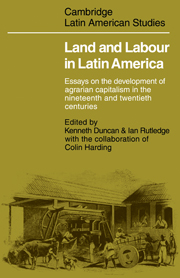 Land and Labour in Latin America
Land and Labour in Latin America Published online by Cambridge University Press: 07 May 2010
The humid pampa of Argentina displays a series of social and economic characteristics that clearly mark it off from other rural areas of Latin America. Relatively speaking, the pampa farm or ranch (empresa rural) has a very high technical level by the standards of the rest of the continent. Its system of social stratification is notably more flexible and diverse than is to be found in the other Latin American republics. At the same time, the existence of a very favourable relationship between the amount of cultivable land and the size of the population means that the Argentine pampas have some features in common with the temperate grasslands of the western United States, Canada, Australia, and New Zealand.
These particular features of the pampa region are certainly not of recent origin - on the contrary, many of them have been present at least since the time Argentina became independent. The causes of this situation were naturally very various. Here I shall confine myself to dealing with three of the most important factors. Firstly, millions of hectares of highly fertile natural pasture land were available in the mid nineteenth century for agricultural development. Secondly, these territories were thinly populated both before and after the Conquest. Moreover, at the beginning of the nineteenth century most of the pampa was practically unexploited, being occupied only by roaming herds of wild cattle and a few tribes of nomadic Indians. The agricultural colonization of this immense frontier of fertile land kept land prices comparatively low throughout most of the nineteenth century, and this enabled various social groups, most of them immigrants, who had grown rich in urban or rural commerce, to acquire a stake in it.
To save this book to your Kindle, first ensure [email protected] is added to your Approved Personal Document E-mail List under your Personal Document Settings on the Manage Your Content and Devices page of your Amazon account. Then enter the ‘name’ part of your Kindle email address below. Find out more about saving to your Kindle.
Note you can select to save to either the @free.kindle.com or @kindle.com variations. ‘@free.kindle.com’ emails are free but can only be saved to your device when it is connected to wi-fi. ‘@kindle.com’ emails can be delivered even when you are not connected to wi-fi, but note that service fees apply.
Find out more about the Kindle Personal Document Service.
To save content items to your account, please confirm that you agree to abide by our usage policies. If this is the first time you use this feature, you will be asked to authorise Cambridge Core to connect with your account. Find out more about saving content to Dropbox.
To save content items to your account, please confirm that you agree to abide by our usage policies. If this is the first time you use this feature, you will be asked to authorise Cambridge Core to connect with your account. Find out more about saving content to Google Drive.